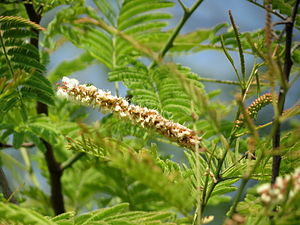Note: This is a project under development. The articles on this wiki are just being initiated and broadly incomplete. You can Help creating new pages.
Acacia ferruginea - Arimedah
Acacia ferruginea is the botanical name of Arimedah. This tree played an important role in the time of Mahabharata. Pandavas hid their weapons on this tree while they left for Agnathavasa. Arimedah belongs to Khadira family.
Uses
Ulcers, Wounds, Bronchitis, Cough, Diarrhea, Skin diseases, Dysentery, Hemorrhages, Dental caries, Intermittent fevers
Parts Used
Chemical Composition
The major objective of the present study was to determine the gene expression of enzymatic antioxidants by acetone extract from the stem bark of three Acacia species in hydrogen peroxide (H2O2)-induced human hepatoma (HepG2) cells. The expression of antioxidant enzymes such as superoxide dismutase containing copper–zinc (CuZnSOD)/manganese (MnSOD), catalase (CAT) and glutathione peroxidase (GPx) in HepG2 cells was evaluated by real-time PCR. [1]
Common names
| Language | Common name |
|---|---|
| Kannada | Banni, Banni mara |
| Hindi | Kaigar, Kalgar, Kingore |
| Malayalam | Karivelam |
| Tamil | Cimai-velvel, Chimaivelvel, Karambai |
| Telugu | Anachandra, Anasandra, Inupa tumma |
| Marathi | NA |
| Gujarathi | NA |
| Punjabi | NA |
| Kashmiri | NA |
| Sanskrit | Arimedah, Brahmashalya, Dvijapriya |
| English | White Bark Acacia |
Habit
Identification
Leaf
| Kind | Shape | Feature |
|---|---|---|
| Bipinnate | Elliptic | Leaf Apex is subacute, Leaf Base is Oblique and Leaf Margin is Ciliate |
.[2]
Flower
| Type | Size | Color and composition | Stamen | More information |
|---|---|---|---|---|
| Unisexual | 2-4cm long | cream to yellow | 10 | Flowering from August-September, Two to three in clusters of terminal panicles |
Fruit
| Type | Size | Mass | Appearance | Seeds | More information |
|---|---|---|---|---|---|
| A sessile | ovoid | A sessile, flat, elongate pod, rusty tomentose, Fruiting from October-February. | seeds 10 | {{{6}}} |
Other features
List of Ayurvedic medicine in which the herb is used
- Vishatinduka Taila as root juice extract
Where to get the saplings
Mode of Propagation
How to plant/cultivate
A plant of drier areas in the tropics where it can be found at elevations from 150 - 1,500 metres.[3]
Commonly seen growing in areas
Photo Gallery
References
External Links
- Ayurvedic Herbs known to be helpful to treat Ulcers
- Ayurvedic Herbs known to be helpful to treat Wounds
- Ayurvedic Herbs known to be helpful to treat Bronchitis
- Ayurvedic Herbs known to be helpful to treat Cough
- Ayurvedic Herbs known to be helpful to treat Diarrhea
- Ayurvedic Herbs known to be helpful to treat Skin diseases
- Ayurvedic Herbs known to be helpful to treat Dysentery
- Ayurvedic Herbs known to be helpful to treat Hemorrhages
- Ayurvedic Herbs known to be helpful to treat Dental caries
- Ayurvedic Herbs known to be helpful to treat Intermittent fevers
- Herbs with Stem used in medicine
- Herbs with Bark used in medicine
- Herbs with Fruits used in medicine
- Herbs with common name in Kannada
- Herbs with common name in Hindi
- Herbs with common name in Malayalam
- Herbs with common name in Tamil
- Herbs with common name in Telugu
- Herbs with common name in Sanskrit
- Herbs with common name in English
- Habit - Tree
- Index of Plants which can be propagated by Seeds
- Herbs that are commonly seen in the region of Tropical area
- Herbs
- Tree




